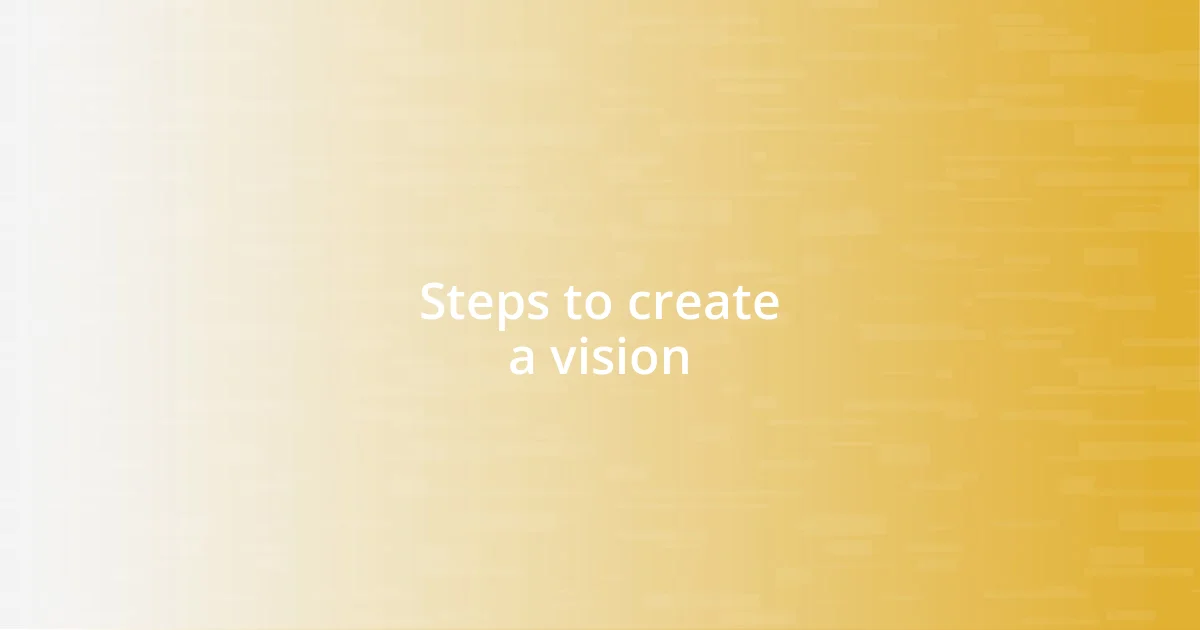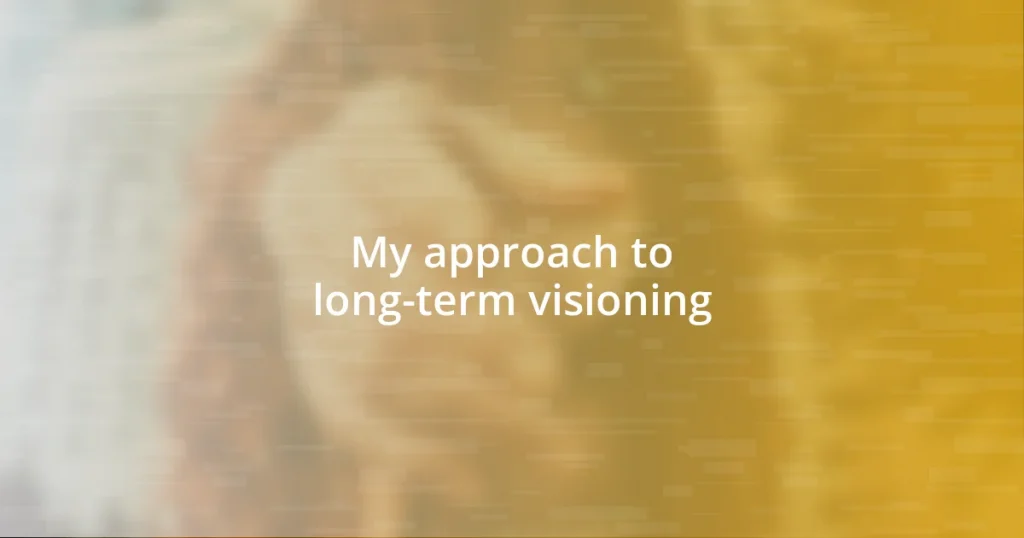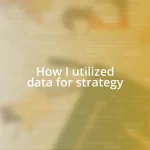Key takeaways:
- Long-term visioning involves reflecting on core values and crafting a vivid, meaningful future, which helps guide daily decisions and enhances personal fulfillment.
- A clear vision serves as a compass for aligning actions with long-term goals, inspiring motivation and fostering connections with like-minded individuals.
- Adapting your vision over time is essential for personal growth, allowing flexibility to embrace new opportunities and changing aspirations as life evolves.

Understanding long-term visioning
Long-term visioning is not merely about setting distant goals; it involves crafting a vivid picture of your future that resonates with your core values. I recall a time when I took a weekend retreat to reflect on what I truly wanted for my life. Surprisingly, it wasn’t just the professional milestones that mattered; my vision illuminated the importance of balance, creativity, and genuine connections with others.
When I think about long-term visioning, I often wonder: how many of us truly spend time defining what we want beyond the next few months? I’ve found that taking a step back and envisioning where I want to be in five or ten years brings clarity to my daily decisions. It’s like having a roadmap; without it, I could easily get lost in the minutiae of daily life, chasing after tasks but missing the bigger picture.
Engaging in this type of visioning can stir a deep emotional response, as it pushes us to confront our hopes and fears. I remember feeling a mix of excitement and anxiety during those moments of reflection, realizing I had the power to shape my own narrative. What if we embraced these feelings as catalysts for change instead of obstacles? This potential is what fuels the journey of long-term visioning, encouraging us to pursue a future that truly aligns with who we are at our essence.

Importance of a clear vision
A clear vision serves as a guiding star in the vast sea of life’s possibilities. I remember a time when I was muddled in decisions about my career path. As I began to define my vision, everything shifted; I became more focused, aligning my daily activities with my long-term aspirations. The clarity I gained acted like a compass, steering me toward choices that genuinely excited me and resonated with my identity.
Thinking back, I’ve realized that a well-articulated vision not only inspires me but also attracts the right opportunities. For instance, during a networking event, I shared my vision during casual conversations. The response was eye-opening—people could sense my passion and were eager to support my journey. It reminded me how a clear vision can foster connections and create a community of like-minded individuals who share similar goals and values.
Ultimately, having a clear vision enhances both personal fulfillment and decision-making. I’ve experienced moments where I was faced with conflicting options, and my vision helped clarify my choices. I felt a sense of relief whenever I evaluated them through the lens of my long-term aspirations. This inner alignment not only simplifies life’s challenging moments but also deepens our emotional resilience, reminding us of the path that leads to our greatest potential.
| Benefits | Consequences of Lack of Vision |
|---|---|
| Focus and Clarity | Distraction and Confusion |
| Inspiration and Motivation | Stagnation and Indecision |
| Stronger Connections | Isolation and Misalignment |

Steps to create a vision
Creating a vision is a deeply personal journey that can transform how we approach life. I remember sitting down one evening, feeling overwhelmed by choices, and just letting my imagination run free. I asked myself what my ideal future looked like, jotting down every thought that came to mind, no matter how grand or simple. It was liberating to explore what genuinely mattered to me, from the type of work I wanted to do to the kind of relationships I wanted to nurture.
Here are some practical steps to help you create your vision:
- Reflect on Core Values: Start by identifying what truly matters to you. I found that spending time pondering my values illuminated paths I hadn’t considered before.
- Visualize Your Future: Picture where you see yourself in the next 5 to 10 years. I often use guided imagery to paint a vivid picture of my goals and aspirations, which grounds me in the present.
- Write It Down: Document your vision. I once filled pages in a journal, which not only organized my thoughts but also provided a tangible reminder of my ambitions.
- Break Down Goals: Divide your vision into smaller, actionable steps. I often create quarterly objectives to help maintain momentum.
- Seek Feedback: Share your vision with trusted friends or mentors. Their insights can offer valuable perspectives that challenge or support your ideas.
- Adapt and Evolve: Remember that visions can change over time. I’ve learned to embrace flexibility, adjusting my vision as I grow and as circumstances shift.
Through this process, I’ve discovered that cultivating a clear vision isn’t a one-time effort; it’s an ongoing practice that requires some emotional investment, too. The anticipation I feel when thinking about future opportunities generates a sense of excitement that keeps me engaged in the present.

Tools for effective visioning
When it comes to effective visioning, tools like mind mapping can truly unleash creativity. I vividly remember the first time I sat with a blank piece of paper, letting my thoughts flow freely. As I branched out my ideas visually, I discovered connections I hadn’t considered and felt invigorated by the clarity that emerged. This method isn’t just for artists; it can be a game changer for anyone trying to articulate their vision.
Another valuable tool is a vision board. I create one at the start of each year, filled with images and words that resonate with my aspirations. The act of cutting out pictures and arranging them on a board is almost like a mini-celebration of my goals. Every time I pass by it, I can’t help but feel inspired to take action. Have you ever considered how a visual representation of your dreams can keep you motivated and focused?
Lastly, journaling is a powerful tool that I find indispensable in the visioning process. I set aside time each week to reflect on my thoughts and feelings about my vision. This practice not only clears mental clutter but also highlights changes that might indicate growth or shifts in my desires. I’ve encountered moments where writing about my vision has reignited my passion or even redirected it entirely. Isn’t it fascinating how putting pen to paper can lead us to deeper insights about ourselves?

Overcoming visioning challenges
One of the biggest hurdles in visioning can be self-doubt. I’ve been there, staring at my ambitions and feeling a wave of uncertainty wash over me. It’s crucial to acknowledge that doubts can creep in, but what I’ve found helpful is to reframe those thoughts. When I feel anxiety about the feasibility of my dreams, I remind myself of past achievements. I ask, “What challenges have I already overcome to get here?” This reflection often reignites my confidence and pushes me to keep pursuing my vision.
Another challenge is the fear of change. We often become comfortable in our routines, even when they don’t align with our long-term goals. I remember a time when I hesitated to leave a steady job for something that resonated more deeply with me. It was scary to step into the unknown, yet I learned that embracing change can become a powerful catalyst for growth. For me, leaning into discomfort became part of the journey. I started viewing change not as a threat but as an opportunity to step closer to my vision.
Lastly, sometimes the sheer scope of long-term goals can feel overwhelming. I used to get lost in the big picture and lose sight of actionable steps. To manage this, I broke down my vision into bite-sized tasks. Each small victory propelled me forward and renewed my motivation. I recall celebrating those tiny successes—noticing how they cumulatively shaped my progress. Have you ever felt that rush of accomplishment from completing a small task? It’s those moments that truly keep the momentum alive as you navigate your vision.

Measuring vision success
Measuring success in visioning can often feel abstract, but I like to set clear milestones along the way. I remember how I turned my long-term goals into quarterly check-ins, reflecting on my progress and adjusting my plans as needed. This not only offered measurable insights but also kept my motivation high—each small win felt like a personal celebration, reminding me of my commitment to my vision.
Tracking emotional responses to my journey has become another crucial aspect of measuring success. There were days when I felt a rush of excitement after a breakthrough, and I began to note these feelings alongside my achievements. When I look back at my journey, the patterns of joy and fulfillment shine through, offering a true gauge of how aligned I am with my vision. Have you ever considered how your emotions can serve as vital indicators of your progress?
Lastly, I frequently revisit my vision board, pondering the images and words I’ve chosen. Each time I do, it prompts me to ask myself: “Does this still resonate with me?” This introspective practice not only reaffirms my goals but also helps me measure how far I’ve come and what might need to change. I cherish these moments of reflection—they create a tangible connection to my vision and reaffirm my purpose, guiding me as I continue to evolve.

Adapting your vision over time
Adapting your vision over time is essential for staying aligned with your evolving goals. I recall when I first set my vision—I was laser-focused on a specific outcome. However, life had other plans. As I faced new experiences and challenges, I realized how crucial it was to allow flexibility within my vision. It became a living document rather than a rigid manifesto. Has your vision ever changed?
Looking back at my journey, I often think about the shifts that were once daunting. For example, after a significant career shift, my priorities transformed. I learned that re-evaluating the path I had laid out wasn’t a sign of failure but rather a testament to my growth. I now view adapting my vision as a natural evolution, one that dictates a willingness to grow in unexpected directions.
There are moments when I feel excited and energized about my vision, and other times when I linger in uncertainty. I remember thinking about how easy it can be to cling to the original dream. Yet, I discovered that each adjustment opens doors to new possibilities. I ask myself, “What would it look like if I embraced this change?” The freedom that comes with exploration and adaptation adds a refreshing layer to my vision, fostering creativity and innovation along the way.















